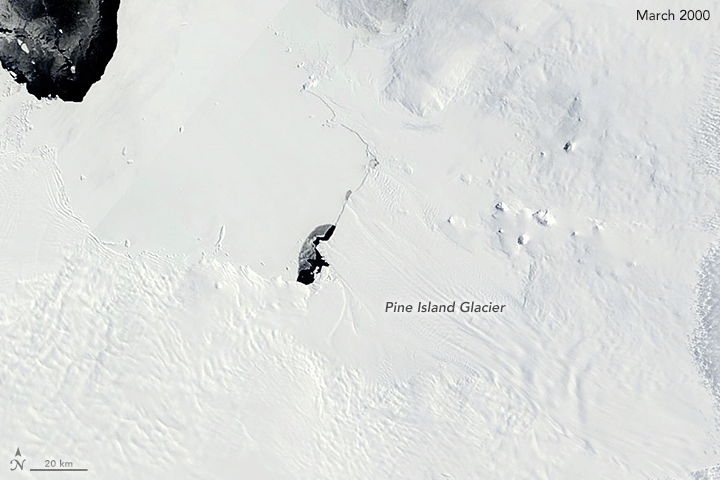


Today’s Image of the Day is an excerpt from our feature story: The Wide View of a Shrinking Glacier—Retreat at Pine Island.
Pine Island Glacier is one of many outlet glaciers around the perimeter of Antarctica, but observations have shown that this glacier is worth extra attention. It is, along with neighboring Thwaites Glacier, one of the main pathways for ice entering the Amundsen Sea from the West Antarctic Ice Sheet and one the fastest-retreating glaciers in Antarctica. Collectively, the region contains enough vulnerable ice to raise global sea level by 1.2 meters (4 feet).
This animation shows a wide view of Pine Island Glacier (PIG) and the long-term retreat of its ice front. Images were acquired by the Moderate Resolution Imaging Spectroradiometer (MODIS) on NASA’s Terra satellite from 2000 to 2019. Notice that there are times when the front appears to stay in the same place or even advance, though the overall trend is toward retreat. Sea ice covering Pine Island Bay comes and goes as the seasons and weather change.
“The process of how a large outlet glacier like Pine Island ‘shrinks’ has some interesting twists,” said Bob Bindschadler, an emeritus NASA glaciologist who landed on Pine Island Glacier’s ice shelf in 2008.
Decades of investigations have given scientists a better idea of the quirks of PIG’s behavior. For example, data collected during science flights in 2009 led researchers to discover a deep-water channel that could funnel warm water to the glacier’s underbelly and melt it from below.
Bindschadler explained that a shrinking outlet glacier is usually doing three things: thinning (mostly at the seaward edge), retreating, and accelerating. The acceleration stretches the glacier, causing the thinning and likely making the ice more prone to crevassing (cracking) upstream.
Fractures near the seaward edge cause the ice to calve off as icebergs, a normal part of life for glaciers that extend over water. If icebergs calve off at a rate that matches the glacier’s acceleration, the ice front stays in the same place.
Bindschadler noted: “This underlies our concern that retreating outlet glaciers can ‘shrink’ rapidly.”
NASA Earth Observatory images by Lauren Dauphin, using MODIS data from NASA EOSDIS/LANCE and GIBS/Worldview.
As this Antarctic glacier sheds huge icebergs more frequently, scientists are closely monitoring the retreat.
Image of the Day for May 13, 2019